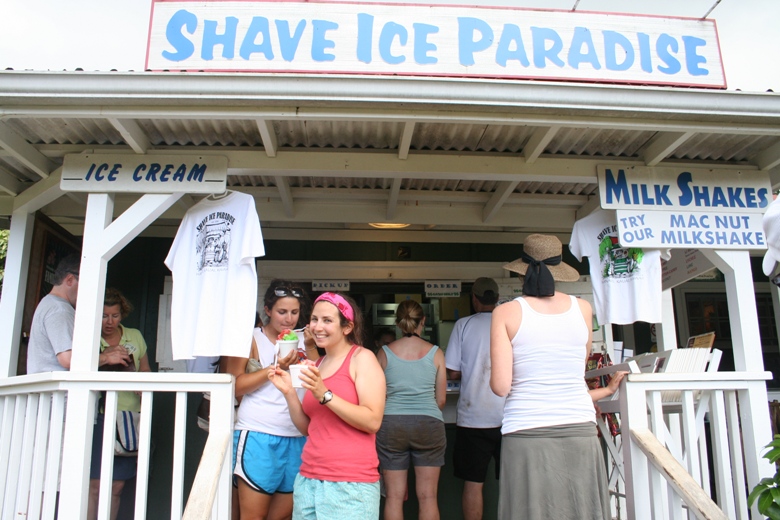On Kauai and more adventures


Cannonball or can opener?
We’re at a swimming hole on private land in Kauai that once belonged to a Hawaiian princess where we’re getting a quick lesson in swinging from a rope swing. A can opener, I learn, is a cannonball with one knee straight.
This very fishing hole, we learn, was used in scenes in the upcoming Pirates of the Caribbean 4.
They say Kauai is the Adventure Island, and we’re sure seeing that this morning. “It is the place to come for outdoor activities, and it’s the most beautiful of the islands,” says Maui Native Eric Dee, who is one of our kayak guides this morning as we kayak two miles up the Hule’ia River where we hike through the woods to the Kipu Ranch, hidden waterfalls, and then our special swimming hole (www.outfitterskauai.com). We pass taro and wild ginger, KuKui Nut trees, the shells that once were fashioned into leis for royalty.
Today, our guides joke, we could find them in Wal-Mart. The wild ginger is called AWAPUHI (squeeze the bulbs and it is great hair conditioner!).
Not bad for a morning on vacation. Other adventures include the chance to paddle along the Na Pali Coast along 2,000 foot sea cliffs, through sea caves, bike down Waimea Canyon, paddle the Wailua River or a kayak trip along with a zip line adventure.
Kauai offers a lot more than the chance to play on the beach. We pass a wall of 480 mangroves brought here by accident when a seed “stowed away” on a merchant ship and ultimately halved the size of the river. There is an ancient Hawaiian fishpond—along with a legend.
We pull the kayaks together to listen to Dakshina Marlier tell the tale: Apparently, the Tahitians negotiated with the famous Menehune to build them fishponds. “Think of it as an ancient Costco,” said Marlier, to catch and then store their fish in the fresh river water. The Menehune king agreed to do it on the darkest night of the month as long as no one watched.
So the story goes, Menehune men stretched 25 miles to pass the lava rock from Waimea Canyon. They’d built 800 feet of the 900 foot wall when they spied the king’s giggling children watching from a hilltop. They scattered and the children were turned to stone and, the legend goes. It took the Tahitians two weeks to finish a fraction of what the Menehune had done in a night.
The moral, I guess: Don’t renege on your word! The river is peaceful. One fisherman is trolling for crab—successfully. The river is about 40 foot wide and 10 feet deep but was twice as wide before the mangrove encroached, our guide tells us. We learn Kauai has the only navigable rivers in all of Hawaii fed from the “wettest place on earth,” Mount Waialeale.
Some people love Kauai for moments just like this–kayaking or tramping through the wood past taro root and wild ginger, never mind the mosquitoes.
“I wanted to show my daughter the things I’d loved here,” said Vicki Pettigrew, traveling with her 17- year old daughter Jenna from Seattle.
“I’ve been coming here since the 1980’s,” said Valerie Russell, who says she has been here more than a dozen times since with her husband and two kids. “That’s how much we love it,” she said, adding they do the kayak trip every time. “We snorkel every day. There is such untouched beauty here…so lush and so green, rainbows every day, and waterfalls…everything a nature lover could want.”
We spent the evening at Luau Kalamaku (www.luaukalamaku.com) which is about as far away from the quiet outdoors you can get—1,000 people watching a luau on the site of Kilohana Plantation, which back in the1930s was a sprawling sugar plantation. Today the mansion—since 1888 a family homestead–houses shops and a restaurant. You can take a train through Kilohana’s 105 acres through exotic fruit and hardwood trees. (The kids will like the chance to feed the wild pigs, sheep, and goats.)
Yes, luaus can be the ultimate touristy experience, but they are also fun with local craftsman displaying wood carvings, jewelry, local spices and syrups. We eat local potato-macaroni salad, Lomi-Lomi salmon and tomato salad (salted salmon was introduced to people here by Western sailors in the 19th Century), locally made tofu tossed with tomato and farm-raised seaweed, Kauai papaya and pineapple.
We taste poi, the Hawaiian staple, ground the traditional way from taro, fresh baked taro rolls (taste better than poi!) Chow Mein (the Chinese brought the noodle to the Hawaiian diet in the mid 1800’s) coconut-mashed purple sweet potatoes, locally grown vegetables with lime leaf and coconut, roasted sweet and sour chicken, fish steamed with local vegetables, and pork that had been roasted underground in an imu (Hawaiian earth oven).
Let’s not forget desserts—local rice pudding, passion fruit sponge cake with dark chocolate ganache, coconut cream and pineapple upside down cake.
But the piece de resistance of the evening is the show that aims to tell the story of the journey to the new land across the Pacific from Tahiti. There are hula dances that depict the struggles as families are separated and the joy when they are reunited. The biggest crowd pleasers, of course, are the fire dancers who are spectacular twirling, jumping, and swallowing fire. How do they do it? How do they catch the flaming torches and twirl them so fast–they are circles of fire.
The audience loves it. We do too. Who says playing tourist is bad?
